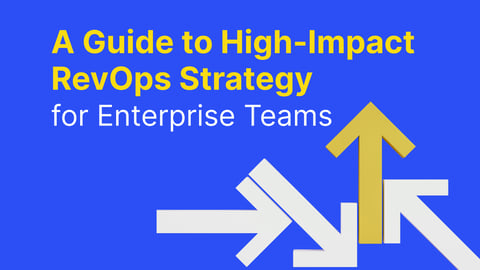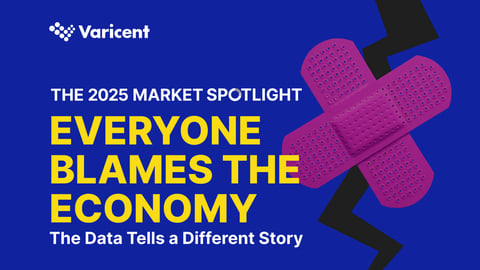On this episode of What I Wish I Knew, I sat down with Sam Cockerill, Chief Commercial Officer at Sama, to discuss the global pivot from ‘growth at all costs’ to repeatable, sustainable revenue.
Listen to the full episode on Spotify.
6 Key Topics:
- Embracing Sustainable, Repeatable Revenue in a Volatile Market
- Identify and Prioritize Ideal Customers
- When Is It Okay to Disqualify a Prospect?
- When Is It Okay to Let Go of a Customer?
- Personalizing Sales Outreach: Open Doors and Build Trust
- How Can You Leverage Artificial Intelligence (AI) in Sales?
Embracing Sustainable, Repeatable Revenue in a Volatile Market
In a world marked by constant market change, Sam emphasized the need for sales leaders to prioritize long-term value over short-term gains.
What’s causing market volatility?
Check out the blog: 11 Factors Creating Market Volatility and the Impact on Sales Forecasting
He outlined 3 ways you can nurture trust and deliver lasting value to your customers:
- Understand your customer’s needs and wants
- Align your sales strategies with their buying journey
- Address obstacles within the revenue engine
Let’s go into detail about the importance of understanding your customer’s needs and wants.
Identify and Prioritize Ideal Customers
One crucial aspect of successful revenue generation is identifying and prioritizing ideal customers. After all, every business story should revolve around its main character – the customer.
Customers are never looking to just buy a product or service; they are looking to solve a problem or achieve a specific goal. It’s critical for sellers and revenue leaders to understand the customer’s ‘job to be done' to effectively position their offerings to appeal to those objectives or solve that problem.
Watch to hear Sam expand on why it’s important to dig into your customer’s pain points?
Sam stresses the importance of uncovering these core jobs through thoughtful discovery questions. Winning a customer’s trust is the end game. By understanding your buyer, sellers position themselves as valuable partners focused on solving their customers' specific needs and aspirations.
Hear more about why interviewing your customer is so essential:
When Is It Okay to Disqualify a Prospect?
Sam emphasizes the significance of filtering out bad-fit customers who can drain resources and divert attention from your truly valuable prospects and customers. By understanding your Ideal Customer Profile (ICP) and aligning sales efforts accordingly, companies can build stronger relationships built on trust and mutual growth.
Instead of assuming that every prospect should become a customer, sellers must be empowered, even encouraged to disqualify potential deals, rather than assume every prospect is a good fit. This mindset allows sales teams to focus their efforts on nurturing relationships with the right-fit customers who are willing to embark on the company's journey.
You need customers who are more of a natural fit for your company’s vision and product roadmap. They should see value in a mutually beneficial partnership.
By disqualifying prospects that are not a good fit, sales pipelines remain accurate, and valuable resources are allocated effectively.
3 reasons to disqualify a prospect:
- They don’t fit in with your ideal customer profile: not the right size, industry, geo, for example
- Wants customizations or product development that aren’t in the product vision or roadmap
- Seeks terms or conditions that creates a custom service model
When Is It Okay to Let Go of a Customer?
First, let’s jump into 3 reasons to disqualify a customer:
- Seeks deeper discounts because they don’t value the full offering of your product
- Consistently asks forconditions
- Wants product changes or to keep features that don’t align with other customers or your product’s growth
These customers can be expensive to acquire, time-consuming to maintain and often steal the resources from others who value and engage with your full offering.
By letting them go, you can focus your resources – engineers, sales, marketing, and customer success teams – towards delivering fruitful results, improving features, and shaping your product’s future.
Hear Sam’s experience with having to disqualify a customer, and the impact it had.
Personalizing Sales Outreach: Open Doors and Build Trust
Personalization is crucial for creating meaningful connections with potential customers. Jacklyn and Sam discussed the significance of tailored outreach in building trust and nurturing relationships.
By conducting thorough research and paying attention to details, sales teams can craft personalized messages that resonate with buyers, setting themselves apart from superficial attempts at connection.
Sam warns against high-friction asks too early – meetings, dinners, and events for example. The goal is to establish trust; Sam stressed that we are all humans at the end of the day, remember to treat buyers as such.
Try thinking of your initial ask as a low-friction offer. Rather than requesting thirty minutes of their time for a demo right away, consider offering high-value , easy-to-consume content. Make it ungated, let the value prove itself as a way to begin building trust
To sum it up:
- Start low friction
- Value their time
- Personalize the outreach in a meaningful way
- Maintain the human element
- Focus on building relationships.
How Can You Leverage Artificial Intelligence (AI) in Sales?
Sam agrees that AI is increasingly becoming a thinking partner for modern businesses. From researching prospects and overcoming the blank page syndrome to extracting insights from conversations and identifying trends, AI-powered conversational intelligence tools can significantly enhance sales and marketing efforts.
By leveraging AI, businesses can streamline communication, save time, and gain valuable insights to inform strategic decisions.
Hear more on Sam’s take on the value of AI in sales.
Valuable Advice for New Sellers
Drawing from his experience, Sam offers valuable advice to new sellers. He encourages them to ask thoughtful questions, listen actively, and embrace silence.
It is essential to let go of the belief that every potential customer should buy their product and instead concentrate on understanding the customer's perspective.
Sam's candid and honest approach to the sales process is grounded in his genuine desire to understand customers and their decision-making process.
Gain a better understanding of your decision-making process as a sales leader with this quiz: What’s Your Decision-Making Style?
Watch the Quick Questions segment to learn more valuable advice and hear what Sam’s dream job was growing up. Spoiler alert: it didn’t have anything to do with sales.
Find Your Locksmith Moment
Sam provided a fresh perspective on revenue generation and consumer-centricity. The locksmith moment of drilling down and truly comprehending why customers need a specific product or service is crucial to building meaningful customer relationships and capitalizing on future opportunities.
No matter how volatile the market becomes, focusing on the customer should never waver.
For a more in-depth look at actions you can take to achieve sustainable revenue in a disruptive market, download the eBook: Achieving Profitable and Predictable Revenue Growth.
Today, organizations need to center their go-to-market strategies around their customers’ buying journey.
Listen to the full episode, Future-Proof for Sustainable Revenue, to gain even deeper insights into revenue generation and the role of the CCO in a rapidly changing market.




